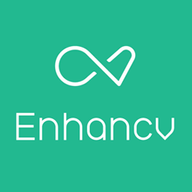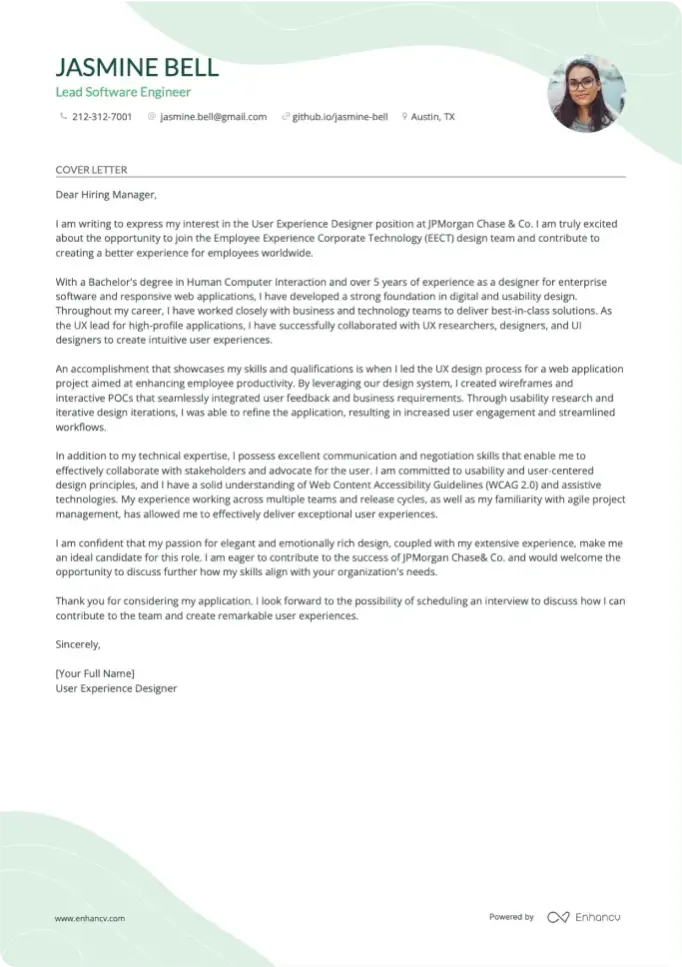Crafting an art teacher cover letter can feel daunting, especially when you're eager to land your dream job. You've polished your resume and found the perfect position, yet the cover letter looms ahead, a blank canvas awaiting your personal touch. Remember, it's not about echoing your resume, but weaving the vibrant story of your proudest professional triumph. Keep it concise, dodge the clichés, and aim to captivate in a single page—your masterpiece of introduction awaits.
- Making excellent use of job-winning real-life professional cover letters;
- Writing the first paragraphs of your art teacher cover letter to get attention and connect with the recruiters - immediately;
- Single out your most noteworthy achievement (even if it's outside your career);
- Get a better understanding of what you must include in your art teacher cover letter to land the job.
Let the power of Enhancv's AI work for you: create your art teacher cover letter by uploading your resume.
If the art teacher isn't exactly the one you're looking for we have a plethora of cover letter examples for jobs like this one:
- Art Teacher resume guide and example
- Grad School cover letter example
- Infant Teacher cover letter example
- Teacher cover letter example
- High School Academic cover letter example
- Daycare Teacher Assistant cover letter example
- History Teacher cover letter example
- Student Teacher cover letter example
- Online Tutor cover letter example
- Language Teacher cover letter example
- Summer School Teacher cover letter example
Drop your resume here or choose a file.
PDF & DOCX only. Max 2MB file size.
Art teacher cover letter example
Scarlett Anderson
Dallas, Texas
+1-(234)-555-1234
help@enhancv.com
- Emphasizes relevant experience in the field of arts education, which is vital for an Arts and Crafts Specialist role, showing that the candidate can design and execute successful curriculum plans.
- Highlights successful event coordination and the ability to engage the local community, demonstrating strong organizational and community engagement skills that are crucial for the role.
- Presents a specific achievement (increasing attendance by 40% at an annual arts exhibit), providing concrete evidence of the candidate's impact and capacity for driving cultural events.
- Ends with a clear call to action by inviting the hiring manager to schedule an interview, underscoring the candidate's enthusiasm and proactive attitude.
Standard formatting for your art teacher cover letter
Structure your art teacher cover letter, following industry-leading advice, to include:
- Header - with your name, the role you're applying for, the date, and contact details;
- Greeting - make sure it's personalized to the organization;
- Introduction paragraph - no more than two sentences;
- Body paragraph - answering why you're the best candidate for the role;
- Closing paragraph - ending with a promise or a call to action;
- Signature - now that's optional.
Set up your art teacher cover letter for success with our templates that are all single-spaced and have a one-inch margin all around.
Use the same font for your art teacher cover as the one in your resume(remember to select a modern, Applicant Tracker System or ATS favorites, like Raleway, Volkhov, or Chivo instead of the worn-out Times New Roman).
Speaking of the ATS, did you know that it doesn't scan or assess your cover letter? This document is solely for the recruiters.
Our builder allows you to export your art teacher cover letter in the best format out there: that is, PDF (this format keeps your information intact).
Struggling to find time to write a cover letter? Try our free cover letter generator to create one in just seconds, straight from your resume.
The top sections on a art teacher cover letter
- Header: Includes your contact information and the date, which is essential for the school administration to easily reach you and for a professional presentation of your cover letter.
- Greeting: Addresses the school principal or hiring committee directly, showing that you have done your research and are genuinely interested in the position at their specific school.
- Introduction: Captures the reader's attention by expressing your passion for art education and your desire to inspire creativity in students, setting the tone for the rest of the letter.
- Body (Teaching Philosophy and Experience): Details your unique teaching approach, relevant experience, and artistic skills, demonstrating how they align with the school’s curriculum and contribute to their art program.
- Closing and Call to Action: Concludes your letter by reiterating your enthusiasm for the role, inviting the hiring manager to review your attached resume or portfolio and prompting them to schedule an interview.
Key qualities recruiters search for in a candidate’s cover letter
- Strong artistic skillset: proficiency in various art mediums and techniques to effectively demonstrate and guide students.
- Creativity and imagination: ability to inspire students and encourage innovative thinking through engaging lesson plans and projects.
- Knowledge of art history and theories: to provide a comprehensive art education that includes historical context and conceptual frameworks.
- Classroom management skills: the ability to maintain a structured and supportive learning environment conducive to artistic expression and learning.
- Experience with curriculum development: a track record of designing and implementing art curricula that align with educational standards and cater to diverse student populations.
- Passion for art education: a genuine enthusiasm for teaching art that motivates and fosters a love of the subject in students.
The art teacher cover letter salutation: how to address hiring managers
After covering the format of your art teacher cover letter, let's look at the salutation.
Back in the day, the cordial "To whom it may concern" or "Dear Sir/Madam", might have worked out fine.
But, nowadays, your cover letter should approach hiring managers on a more personal basis.
So, what to do about your cover letter salutation?
If you've messaged the recruiters and are on a first name basis or a more formal one, use the hiring manager's name in the greeting (e.g. "Dear Sophie," "Dear Ms. Givens", or "Dear Mr. Everett,").
Always aim to make the effort to find out the name of the hiring manager, who'd be assessing your application. Search on LinkedIn, double-check the advert on the corporate website, or message the brand on social media to find out more about the role.
If you can't find the hiring manager's name (and still want to sound professional), use "Dear HR Team,", "Dear Hiring Manager,", or the likes.
List of salutations you can use
- Dear Hiring Manager,
- Dear [School Name] Arts Department,
- Dear [Specific Person's Name],
- Dear Search Committee,
- Dear [School Name] Hiring Team,
- Dear Principal [Last Name],
The art teacher cover letter intro: aligning your interest with the company culture
You only have one chance at making a memorable first impression on recruiters with your art teacher cover letter.
Structure your introduction to be precise and to include no more than two sentences.
Here are some ideas on how to write a job-winning art teacher cover letter introduction:
- get creative - show off your personality from the get-go (if this aligns with the company culture);
- focus on your motivation - be specific when you say what gets you excited about this opportunity.
Choosing your best achievement for the middle or body of your art teacher cover letter
Now that you have the recruiters' attention, it's time to write the chunkiest bit of your art teacher cover letter.
The body consists of three to six paragraphs that focus on one of your achievements.
Use your past success to tell a story of how you obtained your most job-crucial skills and know-how (make sure to back these up with tangible metrics).
Another excellent idea for your art teacher cover letter's middle paragraphs is to shine a light on your unique professional value.
Write consistently and make sure to present information that is relevant to the role.
A sincere and original way to end your art teacher cover letter
When writing their art teacher cover letter, candidates tend to use one of these phrases, "Sincerely yours" or "I look forward to hearing from you".
Both statements show good manners, but your cover letter should end in a more actionable manner.
Write about:
- how you see yourself growing in the role/organization;
- the benefits you would bring about (you'd impress even more with tangible metrics);
- the next steps in the process (provide your availability for interviews).
Addressing limited to no experience in the art teacher cover letter
There's nothing to worry about if you lack professional experience.
Your art teacher cover letter could bridge the gaps in your professional history by focusing on what matters most to recruiters, that's either:
- skills - focusing on transferable ones you've gained, thanks to your life experience (e.g. volunteering, certificates, etc.);
- achievements - select the most relevant and noteworthy one from your history (e.g. education, projects, etc.);
- motivation - describe how you envision your professional growth in the next up to five years, thanks to this opportunity.
Key takeaways
Summarizing the most important aspects in writing your art teacher cover letter, remember to:
- Create a personalized art teacher cover letter for each role you apply for, that includes the recruiter's name in the salutation;
- Format your art teacher cover letter with single-spacing, one-inch margins, and a modern, yet ATS-friendly font;
- Always start off your art teacher cover letter with two sentences that reflect what is most important about your application;
- Your art teacher cover letter body should feature your biggest accomplishments and the job-relevant skills it has taught you;
- Instead of opting for the "Sincerely yours" ending, close your art teacher cover letter with a nod to the future with what you aim to achieve in this potential role.





